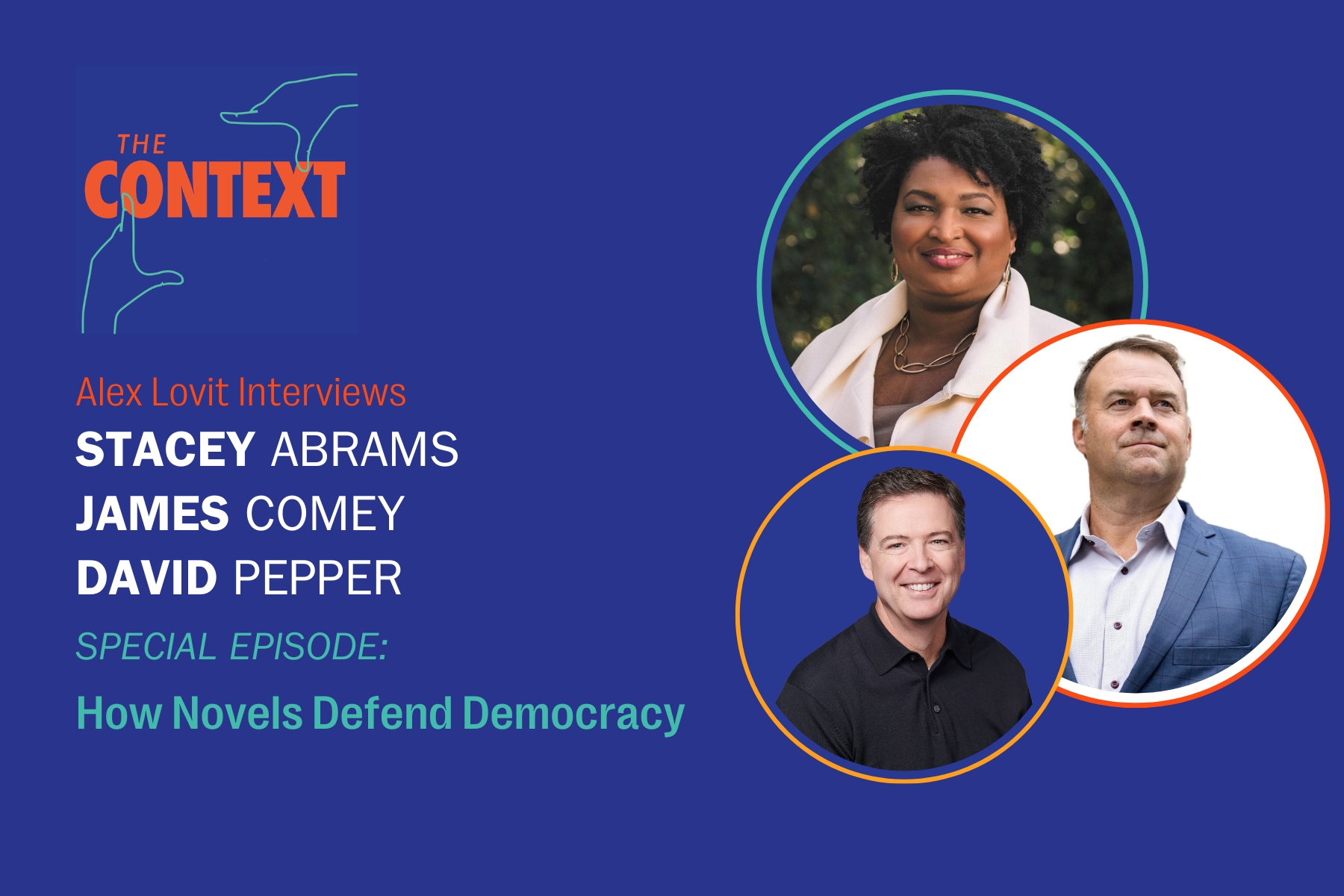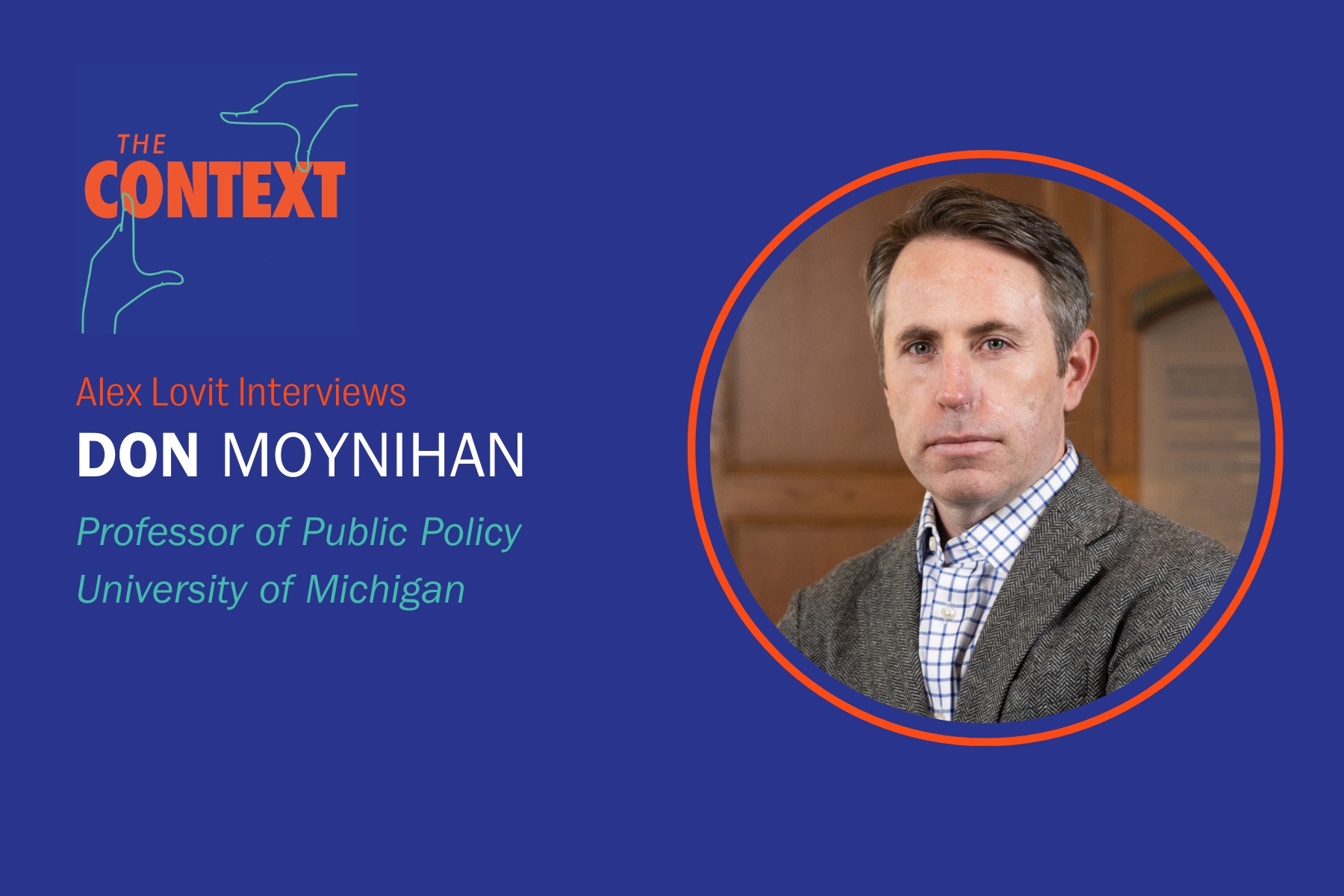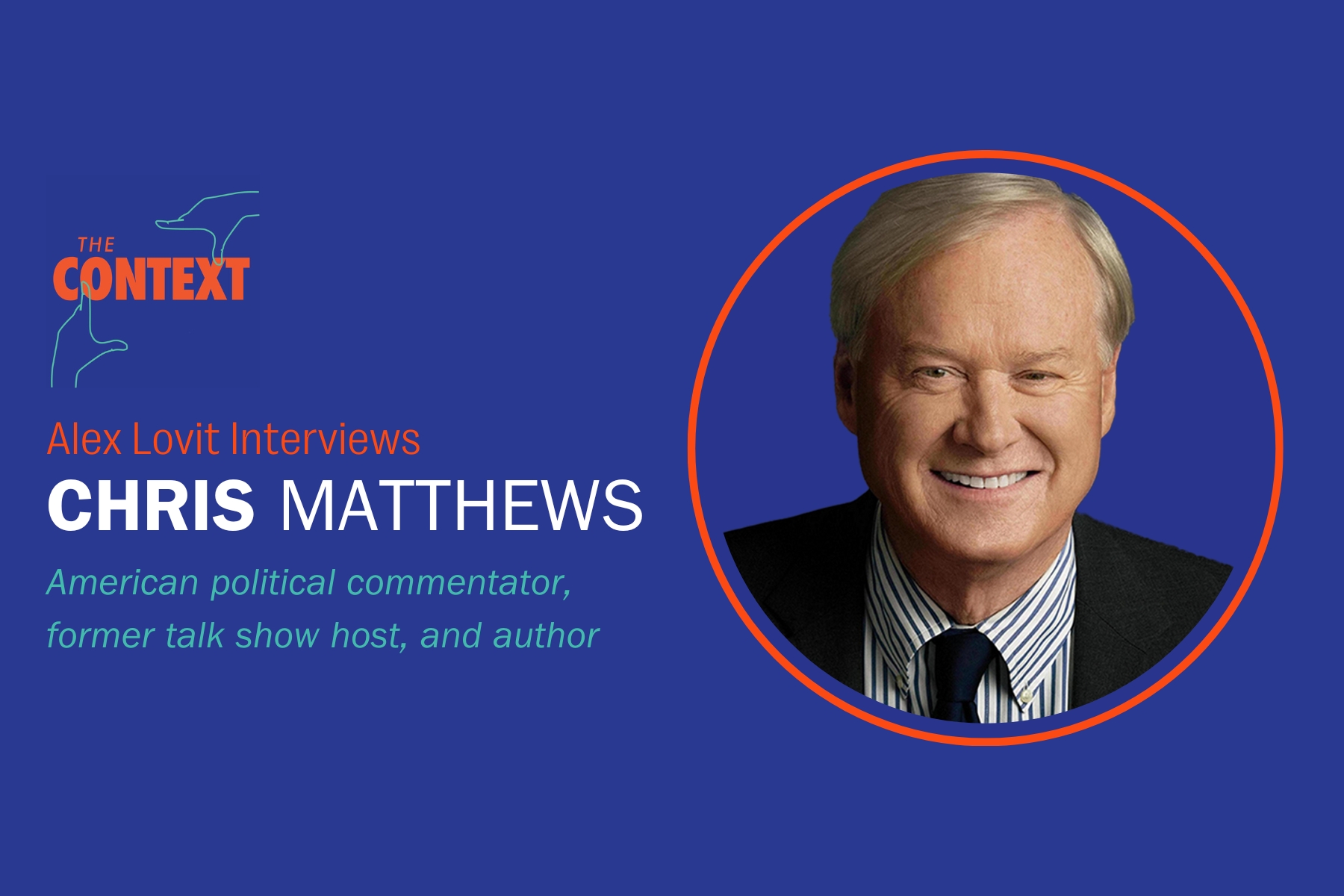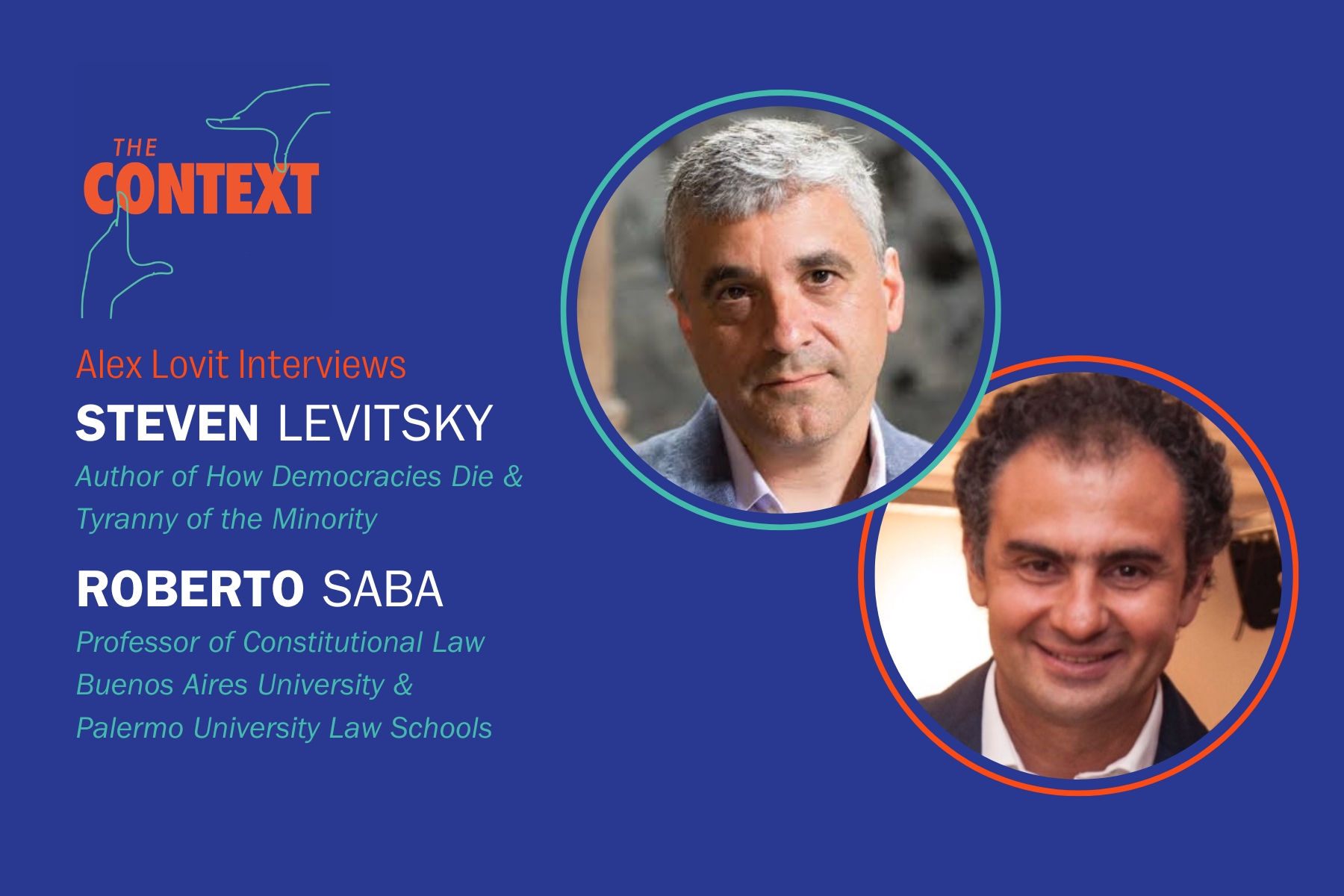Nonviolent Resistance Works. Here’s Why.
Nonviolent movements are more effective at combatting authoritarianism than violent resistance, according to research from today’s guest. Maria Stephan joins host Alex Lovit to discuss the implications of her research for the United States in this moment of political upheaval and growing authoritarianism. Maria Stephan is the co-lead and chief organizer of the Horizons Project. She’s written several books, including co-authoring the award-winning Why Civil Resistance Works: The Strategic Logic of Nonviolent Conflict.
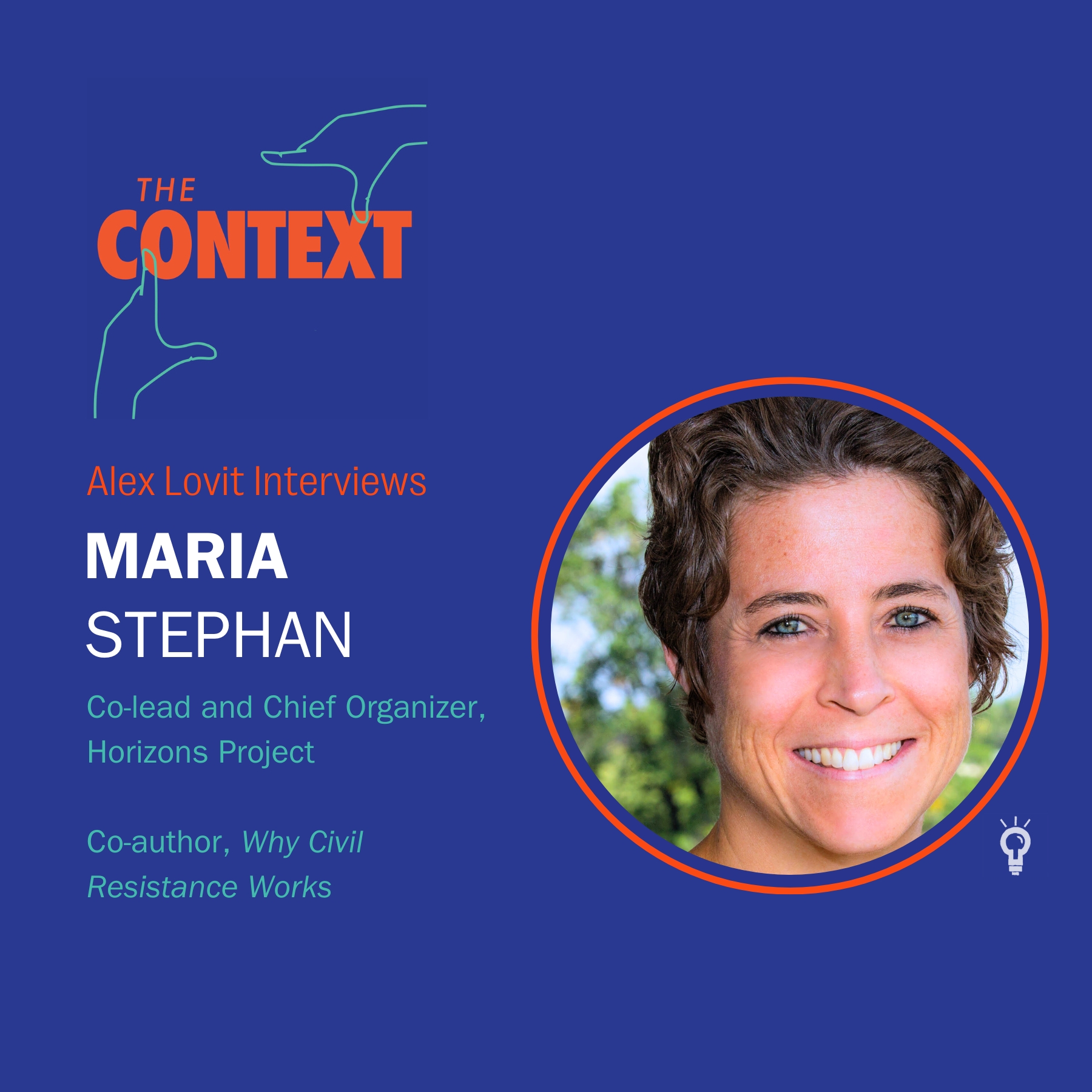
Share Episode
Nonviolent Resistance Works. Here’s Why.
Listen & Subscribe
Nonviolent movements are more effective at combatting authoritarianism than violent resistance, according to research from today’s guest. Maria Stephan joins host Alex Lovit to discuss the implications of her research for the United States in this moment of political upheaval and growing authoritarianism. Maria Stephan is the co-lead and chief organizer of the Horizons Project. She’s written several books, including co-authoring the award-winning Why Civil Resistance Works: The Strategic Logic of Nonviolent Conflict.

Share Episode
Nonviolent Resistance Works. Here’s Why.
Listen & Subscribe
Nonviolent movements are more effective at combatting authoritarianism than violent resistance, according to research from today’s guest. Maria Stephan joins host Alex Lovit to discuss the implications of her research for the United States in this moment of political upheaval and growing authoritarianism. Maria Stephan is the co-lead and chief organizer of the Horizons Project. She’s written several books, including co-authoring the award-winning Why Civil Resistance Works: The Strategic Logic of Nonviolent Conflict.
Alex Lovit: How do you fight an authoritarian regime? I’ve always had a certain image of that in my head. It’s Paul Revere rallying American revolutionaries for Battle against British troops. It’s Luke Skywalker attacking the Death Star. But my guest today says, “If you really want to take down an authoritarian regime, you don’t need firepower. You need people power.” The challenge is building it.
You are listening to The Context. It’s a show from the Charles F. Kettering Foundation about how to get democracy to work for everyone and why that’s so hard to do. I’m your host, Alex Lovit.
My guest today is Maria Stephan. Maria is the co-lead and chief organizer of the Horizons Project. She’s written several books including co-authoring the award-winning, Why Civil Resistance Works. Today she’ll tell us how to build successful anti-authoritarian movements and what we can do right now to mobilize more people in the fight for democracy in the US.
Maria Stephan, welcome to The Context.
Maria Stephan: Thank you, Alex. Good to be with you.
Alex Lovit: So you study non-violent resistance movements and you argue that they can be really powerful, powerful enough to topple a dictator. To start off, let’s just demonstrate that that’s possible. Tell me about a time anywhere in the world where a non-violent civic resistance movement ended an authoritarian regime and allowed a transition to a more democratic form of government.
Maria Stephan: Well, one classic example of a successful non-violent resistance movement was the movement in Chile that ousted the Augusto Pinochet dictatorship in the 1980s. During a period where there were profound abuses of power, disappearances and military dictatorship, the population mobilized, organized using different tactics ranging from mass demonstrations, to protests, to boycotts, to strikes. And when the Pinochet regime called for snap election in 1988, there was a campaign called the No Campaign that brought together all different parts of Chilean society and led with a very affirmative vision of the Chile that people wanted. And this movement was very successful. And when the No campaign won in the plebiscite, Pinochet attempted to overturn the results of the election. And in that case, important parts of the military refused to go along with the attempt to overturn the election. So, the No Campaign prevailed. That was one powerful example.
Also, more recently, the movement in Serbia, the youth-led Otpor movement that mobilized people using very humorous tactics, rock concerts to put pressure on the Milošević regime. And again, when the government attempted to steal the elections, it was every part of Serbian society. So, it was union folks, it was obviously young people and students, women, all involved in various forms of mass mobilization and pressure. So those are a few powerful examples.
Alex Lovit: It’s easy when you’re telling those stories to kind of focus on the end of the story, to focus on that dramatic moment when you have masses of people in the streets. But when those movements started, they’re starting in an authoritarian context. They’re not sure where things are going to go. Talk to me about what work needs to happen leading up to that moment to make it possible.
Maria Stephan: Well, the work that needs to happen is the organizing. And in many of these cases, you think about the Otpor movement that started with about 12 university students who came together and planned a strategy that involved building local affiliates, recruiting people, and training them, recruiting pensioners and retired folks. So, it was the quiet, slow organizing that was so key to success and all the work of training. You think about the role of training during the US Civil Rights movement in church basements to prepare for the violence and the repression that the civil rights activists faced. They planned for various attacks and acts of violence and how to respond, how not to respond. So, it’s the organizing, it’s the training, it’s the preparation, it’s the experimentation with tactics, trying things, acts of defiance and building strength together. So, those are all the elements. And the research on successful non-violent resistance movements really focuses on the importance of momentum. So, it’s not just about a lot of people showing up for mass demonstrations, it’s about the sustained engagement.
Alex Lovit: So, part of what you’re saying is important, there is training and you do some non-violent training yourself. Can you just sketch out briefly what is that training? What are you teaching people to do and why is that so important?
Maria Stephan: Sure. So, I’m a member of the Freedom Trainers, which is a group of trainers that is focused on supporting trainings and workshops on non-violent resistance and non-cooperation. The training starts with a grounding in our context, understanding how authoritarianism and fascism are functioning in the United States, the history of authoritarianism in the US and what it looks like now, the so-called authoritarian playbook. So, going through that grounding and then talking about, “Well, how can we respond? What works?” So the strategies of non-violent resistance, and then really focusing on why non-cooperation is so important. So, it’s student walkouts. It is federal workers who refuse to obey illegal orders. It’s businesses that refuse to allow ICE onto the premises. So, we do trainings and how non-cooperation works and how to build strength in non-cooperation, but a lot of it is organizing, basic organizing within our communities, how to build a broad front, how to think about strategies and tactics that we can do together to build power and to take power away from the authoritarian regimes. We also have been supporting trainings in how to make political violence and repression backfire.
Alex Lovit: Back in 2011, you and a co-author, Erica Chenoweth wrote a book called Why Civil Resistance Works. And that book has been very influential, and if I understood it right, the kind of central idea of that book, or the most basic argument is simply that non-violent movements are more efficacious than violent resistance movements. So, can you just give us a sense of how do you know that? What’s your evidence? Why are you confident in saying that?
Maria Stephan: So, Erica Chenoweth and I joined forces some years ago to better understand when and why resistance strategies succeed. And so, we looked at, at that time close to 330 major armed and non-violent resistance campaigns that challenged authoritarian regimes and that were vying for territorial self-determination. So, these were major political campaigns with maximalist political goals. The surprising finding at the time was that the campaigns that relied predominantly on non-violent resistance tactics, so protests, boycotts, strikes, civil disobedience, were twice as successful as the primarily armed campaigns. So, they succeeded about 52% of the time compared to 26% of the time for the armed campaigns. The most successful campaigns that we studied were those that involved mass diverse participation from all different parts of society and geographically dispersed and very difficult to repress.
So, when you have large numbers of people either walking out or going on strike or refusing to pay taxes, the full range of different non-violent tactics, these campaigns tended to be the most powerful. They generated the most pressure, and they were the most to repress. So, they didn’t just focus on the traditional tactics of protest and marches and demonstrations, all critically important tactics, of course to demonstrate strength in numbers, to demonstrate a sense of unity and solidarity. We found that those tactics were important and being able to use tactics like non-cooperation tactics, the consumer boycotts, the strikes, soldiers in security forces refusing to obey orders to crack down on peaceful protestors. So, being able to draw on a wide variety of different tactics was also key to success.
You may have heard the statistic based on this research that no regime has remained in power when 3.5% of the population has engaged in active protest. What that means is that you don’t need 50% of a population to be engaged in active resistance. You don’t need 25%. You need a fairly small percentage of the population to be engaged in sustained protest activity. So, this is not just showing up for one day of demonstration, it’s the sustained activity resistance over time. So, that gives hope to a lot of people in the sense that we don’t need masses and masses of people, we need a lot of people, but more it’s the focused organization. It’s the diversity of participation, it’s being able to develop campaigns that target the institutions and organizations that are supporting an authoritarian regime. Those are the elements that contribute to success.
Alex Lovit: So, if I am trying to lead an anti-authoritarian resistance movement, and I’m coming to you for advice and I’m asking, “Well, help me understand why I should be non-violent rather than violent? Help me understand the mechanics of why violence is not going to be as effective.” Explain that to me.
Maria Stephan: Non-violent campaigns tend to attract significantly larger numbers of people from different parts of society, and we need the active participation of many different people from all walks of life who have different abilities, different professions, different interests. So, non-violent resistance, because it involves so many different types of tactics, everything from quiet acts of disruption to go slow tactics to consumer boycotts, there are many things for people to do. And so, when you have large numbers of people engaged in these acts of defiance or pressure, this gives a movement strength. So, if you want to be strategically successful in bringing a lot of people into the movement and bringing a lot of power into the movement and if you want to achieve defections in key institutions that are upholding a regime who may be turned off by violent tactics, being able to focus on non-violent discipline to bring lots of people into the movement is critically important.
Alex Lovit: So, it’s going to be harder for me to get 3.5% of the population if it’s an army, if they’re going to get shot.
Maria Stephan: Yeah. I mean, but it’s important to clarify that non-violent discipline does not mean that the movement will not face violence. And there’s often a profound amount of state violence, crackdowns, vigilante activity. But when a movement maintains non-violent discipline and involves the active participation of people from different parts of society, including those who are close to the regime or closer to the regime, then the use of violent repression against the movement is more likely to backfire against the regime. It’s more likely to raise the social, political and economic costs of repression, whereas it’s easier for a regime to justify violent crackdowns when the movement itself is using different violent tactics. But again, just to clarify that often in these campaigns, the predominance of violence is coming from the state. And so, the key is being able to maintain discipline, both to bring more people into the movement and to make the opponent’s use of violence and repression backfire so that they pay a price for targeting a predominantly non-violent discipline movement.
Alex Lovit: What you’re describing there is a circumstance in which there’s sort of an organized violent resistance to an authoritarian regime, which is also using violence. That feels a little different than the type of violence we’re seeing in the United States recently. We’re seeing assassination of politicians and political figures that is not necessarily organized by any kind of group, and the goal is not necessarily regime change either. Can you help us understand how that type of violence, the type of violence that the United States is experiencing recently affects our society and our politics?
Maria Stephan: Political violence in general tends to diminish political participation. People are fearful. They will be more reluctant to show up for certain events. And so, political violence just has a dampening effect on democracy and on civic participation. It also highlights just how important being able to engage in different tactics. So, of course, the mass rallies and demonstrations are so important and there’s strength in numbers and being able to engage in dispersed tactics, so there’s not as much of a risk for certain people. So, banging pots and pans on the roofs, which is what is happening as part of the Free DC movement, or using your consumer buying power to target corporations that are enabling various forms of authoritarianism, including ICE activities, but the best antidote to political violence and threats and intimidation is disciplined non-violent resistance, I believe.
Alex Lovit: Well, let’s talk about how to apply the things you’re talking about to the current moment in the United States. So, I am seeing authoritarian tendencies of the regime in power right now. I’m pretty worried about that. I’m worried about limits on free speech. I’m worried about changes to election law that could make elections less fair going forward. But I’m looking around and there’ve been protests, even some pretty big ones, but nothing that’s getting at that 3.5% number. How should I think about that problem? What should we be doing right now?
Maria Stephan: I mean, I think it’s important to note that there is a lot of protest activity happening across the country. It’s maybe not always out there in the mainstream media, but if you look at the level of protests happening and its geographic dispersion, there’s actually about three times the level of protests happening now, or at least the first three or four months of this year compared to the same period eight years ago. And of course, the major rallies like Hands Off and No Kings have brought millions of people out into the streets, 5 million or 6 million for the last No Kings demonstration. And you’re also seeing mass mobilization in location.
So, I’m thinking now about the response in LA, in Chicago to the ICE raids and to the deployment of the National Guard. So, I think it’s important to just see all that’s happening. And yes, there’s not a mass mobilization moment, but I think the way to think about it is that we’re in a moment where we are finding each other, we are building muscle, we are acting collectively, and it takes time to be able to generate the kind of mass participation and collective action that I know we are going to need in the months and years ahead.
Alex Lovit: So, if I’m thinking like an organizer and I sort of have that 3.5% number in mind with the United States, 3.5% of the population is more than 10 million people. It’s a lot of people. So, I’m trying to build my movement to get to that point. Should I be thinking about sort of a pivot point that the initial goal is to build the movement and then to pivot to the mass non-cooperation that will slow down the regime?
Maria Stephan: I think you are building a movement and engaging in actions together. They’re inextricably linked. So, I think building the movement does involve organizing in communities, and it also involves taking action together. That’s how you build the muscle. That’s how you build momentum. That can be small things in communities. I’m thinking about the example in Idaho of the teacher, Sarah Inama, who was told to take down the sign in her classroom, Everyone is Welcome Here. She refused. And not only that, that action catalyzed action throughout the community. So, local businesses printed out 20,000 T-shirts with the message, Everyone is Welcome Here. And so, small actions can have large ripple effects. I’m thinking about the case of the Naval Academy when Secretary Hegseth and the DOD told the librarians, “Take the books out of the bookshelves,” almost 300 books because they focused on diversity, equity, inclusion issues. And you had then mass mobilization by alumni of the Naval Academy, including retired commandants who pushed back and said, “This is an existential threat to the institution.”
And so, they organized and they also allied with a local bookstore to purchase all of the books that had been removed. And it was a successful campaign. They were able to get all of the books except for I think a small number put back on the shelves. So, these small community actions can have large effects. And that’s another thing that we’ve observed globally is that in the moment, when there have been pro-democratic victories, mass mobilizations, often they were very difficult to predict. It seemed like the opposition was losing, things weren’t changing, the repression was growing. And then because there had been organizing happening, things below the surface, groups that had come together across difference, then you had sometimes dramatic effects of authoritarian regimes being forced to leave power. So, I think we can take heart that tactics and actions build on one another. They reinforce one another, and that is kind of the strength that we’re going to need for the bigger moments ahead.
Alex Lovit: You’re emphasizing there, there can be kind of an unpredictable moment when a video goes viral or something happens that brings a lot of new people into the movement. And by definition, those new people won’t have gone through the training. They won’t have been part of those conversations until that point. How should movements approach that?
Maria Stephan: Exactly right. There will be trigger events, and sometimes they can be difficult to predict in advance, but in that moment then, when large numbers of people decide they want to take action, there have to be ways for them to get involved. There have to be community groups for them to join. There have to be actions and tactics that they can use. And so, those are the moments of the trigger events leading to mass participation, to then being able to absorb those people, bringing them into the movement in different ways, whether it’s joining an indivisible chapter or joining a faith-based organization or a 50501 or whatever to give them a home to then be able to stay engaged over time. And that kind of sustained engagement is what is so key, I think, to be able to have power in this context.
Alex Lovit: Talk to me about why it’s important to start now. So, if we’re thinking about building a movement that will build over time, there could be a temptation to think, “Well, I’ll join when we get to that 3.5% number. I’ll be part of the mass resistance at that point.” Why is it important that people be part of the resistance movement right now in this moment?
Maria Stephan: I mean, in part because we’re all being affected by what is happening in our country. We’re all being affected by the abuses of power, by the attacks on our community, by the abductions, by the threats, harassment and intimidation. So, standing up and taking action builds the strength and the confidence for others to join. So, when we’re out there doing seemingly small things, out with a sign on the street corner or joining a local vigil, we are normalizing dissent. We are mainstreaming the idea that what is happening in this country is unacceptable and people will not go along with it. And so, it may seem small, but you are creating an ethos of solidarity and defiance, and that is what builds up over time to more collective action.
No major changes in our country’s history or around the world have started big. They always start with a small group of concerted people who then organize and other people join. And there has to be a way to welcome them in, including people who are maybe not on our side to begin with. At a certain point, people feel what is happening, and that’s when we need to be able to provide opportunities through our movements, through our faith organizations, through our community groups, to be able to support people getting more involved.
Alex Lovit: In the United States, we’ve had problems with our democracy, problems of non-representation, gerrymandering, voter access, all sorts of problems. And in some ways, those problems may have contributed to the political crisis we’re in right now, people feeling like the system wasn’t working. Do you see ways that a non-violent movement in the United States right now could lay the groundwork for a rebirth of American democracy, for improving American democracy?
Maria Stephan: I do. And I think people who are imagining a better democracy for this country, who are imagining what does a thriving democracy look like, where everyone’s dignity is respected, where there are basic human rights that are respected, where we finally address the corrosive effects of money and politics. Dr. King referred to it as a beloved community where everyone belongs and can flourish. Now is the time to be putting those big ideas on the table. And I think that goes hand in hand with resistance. So, we need to vociferously no to the things that are wrong and the abuses and the acts of authoritarianism that we’re facing on a daily basis. So, we need that resistance. We need that blocking and to attract more people into the movement, we need an affirmative vision. What are we fighting for? What are the big ideas? What are the ways we want to live together? So, I think these are inextricably linked.
Alex Lovit: Speaking of the ways that resistance can build democratic muscle, a lot of people feel disillusioned. They don’t think their voices matter. How can we help spark a sense of agency, make people feel that their voices do matter, and they do have power?
Maria Stephan: Looking at examples where communities have come together, they have flexed civic muscle and they’ve been successful. One of the recent examples of this is the civic campaign targeting Avelo Airlines. So, Avelo Airlines is the premier airline carrier for ICE deportation flights. And communities across the country, in places like New Haven, Connecticut found out about this relationship. Meanwhile, flight attendants from Avelo Airlines were leaking information about deportation flights, and they organized, they mobilized, they put pressure on the company, including through their local councils. They pressured local councils to cut transportation subsidies to Avelo Airlines. So, as a result of the Stop Avelo campaign, today, the West Coast operations for Avelo has shut down. I think the examples of communities that have organized and mobilized to bring about the release of immigrants and people in communities who were taken by ICE agents, so I’m thinking about Sackets Harbor when children, including a third-grader, an eight-year-old were taken by ICE agents.
The community responded by walking out, by marching, by showing up, and their action resulted in the release of the immigrants. And so, I think it’s holding on to the ways that our actions are leading to concrete results and bringing communities together in the process. So, I think we do have voice and that we assert it in different ways. And so, one thing, when you think about democratic backsliding context or like semi-authoritarian context, voting becomes not just the civic thing to do, the civic responsibility. It’s also an act of defiance because these regimes don’t want you to vote necessarily, or they want you to stay home. They’re trying to threaten or intimidate you. So, showing up is a way to participate meaningfully and to not comply with what the authoritarian wants you to do. So, we need all different types of civic participation. Voting is critically important. Advocacy activities are critically important, and the direct action, the mobilization, the protest activity, all is needed, all matters in this moment.
Alex Lovit: Maria Stephan, thank you for joining me on the context.
Maria Stephan: Thanks, Alex.
Alex Lovit: The context is a production of the Charles F. Kettering Foundation. Our producers are George Drake Jr. and Emily Vaughn. Melinda Gilmore is our director of communications. The rest of our team includes Jamaal Bell, Tayo Clyburn, Jasmine Olaore, and Darla Minnich. We’ll be back in two weeks with another conversation about democracy. In the meantime, visit our website kettering.org to learn more about the foundation or to sign up for our newsletter. If you have comments for the show, you can reach us at thecontext.kettering.org. If you like the show, leave us a rating or a review wherever you get your podcasts, or just tell a friend about us. I’m Alex Lovit. I’m a senior program officer and historian here at Kettering. Thanks for listening.
The views and opinions expressed in this podcast are those of the host and guests. They’re not the views and opinions of the Kettering Foundation. The Foundation’s support of this podcast is not an endorsement of its content.
Speaker 3: This podcast is part of the Democracy Group.
Transcripts are created on a rush deadline by a Kettering Foundation contractor and may contain small errors. The authoritative record is the audio recording.
More Episodes
- Published On: January 14, 2025
The separation of church and state is a foundational principle of American democracy, but that doesn’t mean that religion hasn’t played an...
- Published On: December 17, 2024
“Administrative burdens” is a term for the frictions people experience when interacting with government—learning how a program works, taking the time to...
- Published On: December 3, 2024
In 2015, Crossroads Church, a majority-White evangelical megachurch based in Cincinnati, Ohio, launched a new program to address racial division and racism....
- Published On: November 19, 2024
Donald Trump has been elected the 47th president of the United States. He will enter the White House with his party in...
- Published On: November 5, 2024
Argentina’s constitution is among the oldest democratic constitutions in the world, and in significant respects it was modeled after the constitution of...

